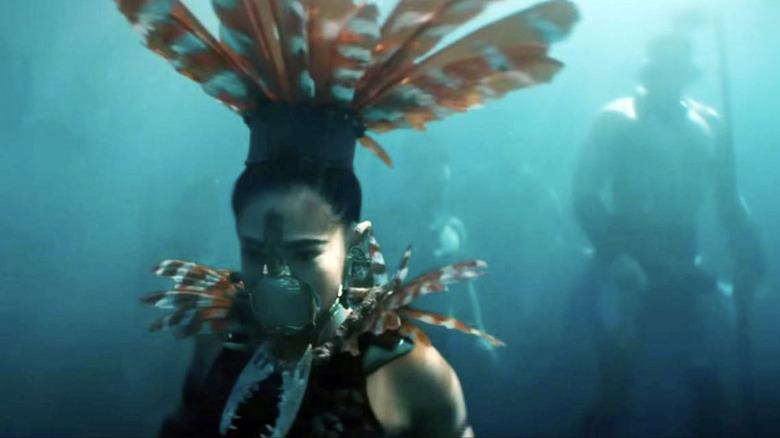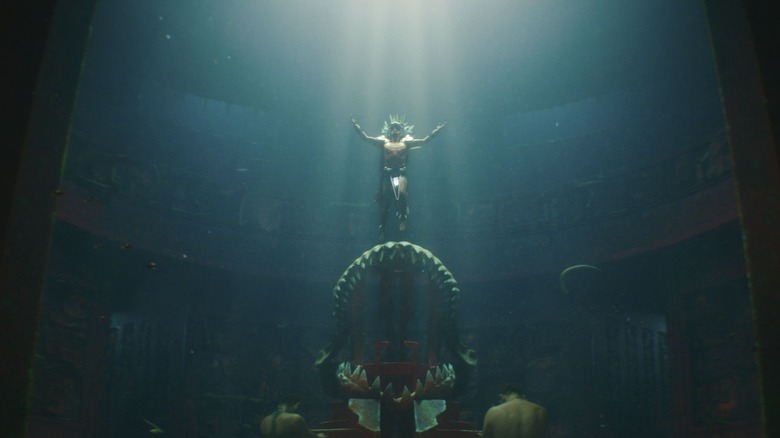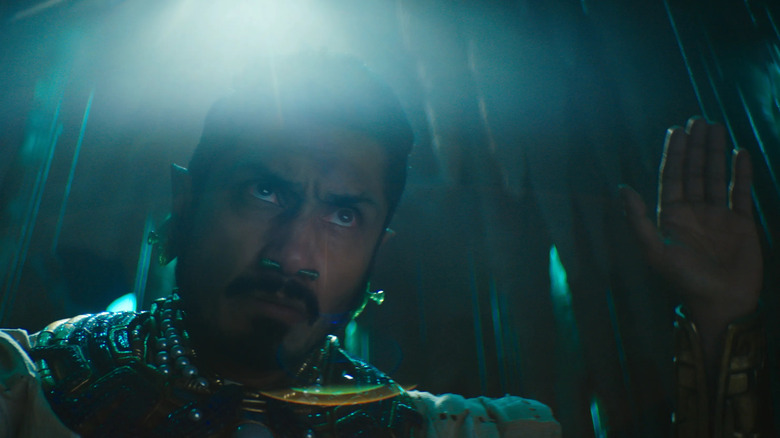How Black Panther: Wakanda Forever Matched Its Underwater Shots To The Ones On Land [Exclusive]
This post contains mild spoilers for "Black Panther: Wakanda Forever."
Ryan Coogler's film "Black Panther: Wakanda Forever" is a vast and complex fantasy film that centers on a potential war between the titular high-tech fictional African nation and the vast, ultra-powered underwater Mesoamerican/futurist kingdom of Talokan. The former uses an underground deposit of a rare, magical metal called vibranium to power advanced, fantastical machines like flying saucers and feather-light, indestructible, flying suits of armor. The latter also possesses a store of vibranium and has constructed a miniature underwater sun, that has sustained a lost race of merpeople for generations. While the plot of "Wakanda Forever" occasionally gets lost in the (sea)weeds, its envisioning of two rival fantasy countries is one of the more impressive visual accomplishments of the year's cinema.
"Wakanda Forever" was impressively photographed by cinematographer Autumn Durald Arkapaw, and her job was made especially complicated by the film's extensive special effects. Much of the Talokan sequences take place underwater, and the celebrated New Zealand special effects workshop Wētā FX was called in to create believable facsimiles. This was far more than a matter of CGI animation, though. Wētā had to look at the photography that Arkapaw had constructed, and find ways to recreate that artificially.
/Film's own Ben Pearson recently talked with Chris White, Wētā's VFX supervisor on "Wakanda Forever," and he went into detail about what he and his crew had to do to bring Talokan to life. Because Arkapaw was building custom lenses for the dry-land sequences, White had to figure out novel ways to make her inventions function — virtually — and underwater.
Detuning lenses
"Wakanda Forever" was shot using Panavision Ultra Vista lenses for its 2.39:1 aspect ratio scenes, with Sony CineAlta Venice IMAX, Panavision C- and T-Series lenses used for its 1.9:1 IMAX scenes. It was not shot on 35mm film (quite a rarity these days), but on AXS-R7 6k digital masters. Additionally, Autumn Durald Arkapaw altered her lenses to mildly alter and slightly degrade the image to give it a more old-world, authentic look. This alteration is, in photography lingo, detuning. Altering lenses to achieve a certain visual "heft" is not uncommon in filmmaking.
Chris White was sensitive to Arkapaw's detuning and paid very close attention to her looks. This was vital in a film that cut rapidly between on-set photography and digitally created shots to retain continuity. White says:
"Our VFX shots needed to look exactly as how they were filming the live-action shots from the DP in terms of her lenses and the creative choices. Because she was building custom lenses and detuning them to give this anamorphic look, and it was important that when you cut to a visual effects shot, it looked exactly like what she had shot and that we had the same kind of creative controls to adjust those things."
So when Shuri (Leticia Wright) visits Talokan's king Namor (Tenoch Huerta Mejía), and he takes her on a tour of his marvelous undersea realm, it won't be so jarring when the action cuts back to Riri Williams (Dominique Thorne) waiting back in a live-action grotto.
The bokeh visuals
Another piece of photography lingo is "bokeh," a word you may have seen on home photo editing software. It's a term that generally refers to the way a lens captures light sources when they're out of focus, lending an aesthetically pleasing blur to an image. Bokeh isn't limited to light sources, however, and can refer to anything outside of a picture's field of focus. Film photographers have internalized these types of aesthetics and Autumn Durald Arkapaw had a very specific look she wanted to achieve.
Chris White talks about working with other FX supervisors on how to create a lot of detail and then, in his word, defocus them. Once the aesthetic had been captured, he also had to consider what general tone a scene was trying to strike. A great deal of creativity was required. In his words:
"It was a lot of assistance from the onset crew and the associate visual effects supervisor, Michael Ralla. They scanned and shot every lens, all kinds of grids, all kinds of information that we could bring in, and just match every little aspect of it. Because they would have long creative discussions about how to defocus and bokeh looks on the front side, how it looks on the back side, how the edges are. All of that was a lot of creative decisions. So it was not only just replicating the lens, it was understanding what was happening."
"Wakanda Forever," in paying so much attention to making its fantasy kingdoms look natural, created a lovely visual milieu in which superheroes could clash. After all the glittering and impressive visuals, the actual action almost felt lackluster in comparison. Living in Talokan is more impressive than fighting there.


